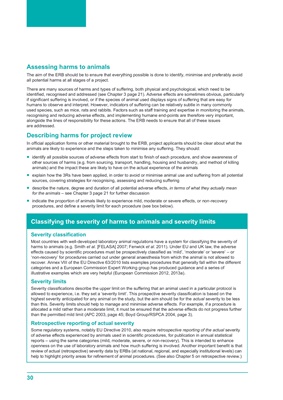
30
Assessing harms to animals
The aim of the ERB should be to ensure that everything possible is done to identify, minimise and preferably avoid
all potential harms at all stages of a project.
There are many sources of harms and types of suffering, both physical and psychological, which need to be
identified, recognised and addressed (see Chapter 3 page 21). Adverse effects are sometimes obvious, particularly
if significant suffering is involved, or if the species of animal used displays signs of suffering that are easy for
humans to observe and interpret. However, indicators of suffering can be relatively subtle in many commonly
used species, such as mice, rats and rabbits. Factors such as staff training and expertise in monitoring the animals,
recognising and reducing adverse effects, and implementing humane end-points are therefore very important,
alongside the lines of responsibility for these actions. The ERB needs to ensure that all of these issues
are addressed.
Describing harms for project review
In official application forms or other material brought to the ERB, project applicants should be clear about what the
animals are likely to experience and the steps taken to minimise any suffering. They should:
identify all possible sources of adverse effects from start to finish of each procedure, and show awareness of
other sources of harms (e.g. from sourcing, transport, handling, housing and husbandry, and method of killing
animals) and the impact these are likely to have on the actual experience of the animals
explain how the 3Rs have been applied, in order to avoid or minimise animal use and suffering from all potential
sources, covering strategies for recognising, assessing and reducing suffering
describe the nature, degree and duration of all potential adverse effects, in terms of what they actually mean
for the animals - see Chapter 3 page 21 for further discussion
indicate the proportion of animals likely to experience mild, moderate or severe effects, or non-recovery
procedures, and define a severity limit for each procedure (see box below).
Classifying the severity of harms to animals and severity limits
Severity classification
Most countries with well-developed laboratory animal regulations have a system for classifying the severity of
harms to animals (e.g. Smith et al. [FELASA] 2007; Fenwick et al. 2011). Under EU and UK law, the adverse
effects caused by scientific procedures must be prospectively classified as "mild", "moderate" or "severe" - or
"non-recovery" for procedures carried out under general anaesthesia from which the animal is not allowed to
recover. Annex VIII of the EU Directive 63/2010 lists examples procedures that generally fall within the different
categories and a European Commission Expert Working group has produced guidance and a series of
illustrative examples which are very helpful (European Commission 2012, 2013a).
Severity limits
Severity classifications describe the upper limit on the suffering that an animal used in a particular protocol is
allowed to experience, i.e. they set a "severity limit". This prospective severity classification is based on the
highest severity anticipated for any animal on the study, but the aim should be for the actual severity to be less
than this. Severity limits should help to manage and minimise adverse effects. For example, if a procedure is
allocated a mild rather than a moderate limit, it must be ensured that the adverse effects do not progress further
than the permitted mild limit (APC 2003, page 45; Boyd Group/RSPCA 2004, page 3).
Retrospective reporting of actual severity
Some regulatory systems, notably EU Directive 2010, also require retrospective reporting of the actual severity
of adverse effects experienced by animals used in scientific procedures, for publication in annual statistical
reports - using the same categories (mild, moderate, severe, or non-recovery). This is intended to enhance
openness on the use of laboratory animals and how much suffering is involved. Another important benefit is that
review of actual (retrospective) severity data by ERBs (at national, regional, and especially institutional levels) can
help to highlight priority areas for refinement of animal procedures. (See also Chapter 5 on retrospective review.)